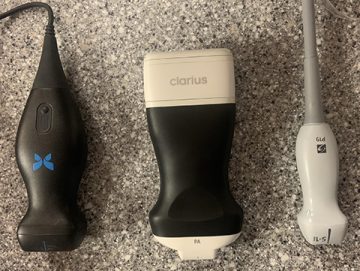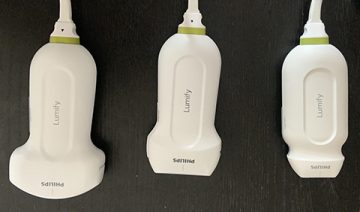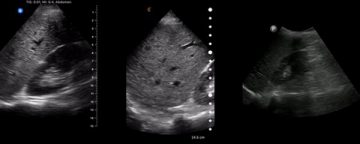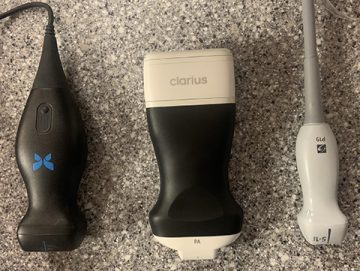Note from TCMP editors:
This week’s article is different than traditional TCMP articles, but we thought we’d try something new and seek your feedback. Instead of an overview of a practice-changing piece of evidence, it’s a review of several commercially available portable ultrasound devices. We do recognize this, by definition, focuses on brand-name products, but there aren’t any “generic” ultrasound devices, and we felt the authors did a balanced review. Much like any review of cars, dishwashers or smartphones, the specific make and model matters. In posting this article, we’re seeking feedback: would you like to see more of these product review articles, looking at devices, technology, and apps? Or should we restrict our article types to the ones you are used to seeing on TCMP? Please send feedback to contact@edaily.vn.
By Philip Lee MD CCFP-EM (biography and disclosures) and Stefanie Falz Mclellan MD CCFP-EM (biography and disclosures)
Disclosures: Dr. Lee purchased a team subscription with an Ontario group for a Butterfly iQ which was used to acquire some of the scans. Dr. Mclellan received a subsidy through the RCCbc IN PoCUS project to purchase a Clarius phased array probe. At the time of writing, she had not received the probe yet.
What we did before
The integration of point of care ultrasound (PoCUS) in the emergency department workflow is not always easy, and these challenges have been amplified in the time of COVID-19. Typically, you have to locate the ultrasound machine and hope it is not parked in some random spot in the hospital. Then, you hope the last user wiped it down and plugged it in properly so it is charged and ready to go. Finally, you have to wheel the machine to the patient’s bedside, which often feels like an obstacle course involving loose cords, bedsheets, and hallways packed with parked equipment, IV poles, and other obstacles.
The COVID-19 pandemic has created new challenges and opportunities for this diagnostic tool. Recent research has found that ultrasound can be a useful tool to detect signs of COVID-19 pneumonia [1], whereas chest x-ray is often negative [2]. Further, CT scans and chest x-rays present infection control challenges in suspected COVID-19 cases, making bedside ultrasound an attractive option. Despite this, cleaning a cart-based ultrasound machine following exposure to a confirmed or suspected COVID-19 case is rigorous and time-consuming [3].
What changed our practice
Enter the handheld!
Handheld ultrasound devices have been available for several years. However, historically, image quality has been a concern and the cost has been prohibitive. The COVID-19 pandemic has led to an increased interest in the use of handheld ultrasound devices as they simplify infection control procedures and take up little space in emergency rooms crowded with critical care equipment.
As a result, multiple manufacturers have responded by developing new, lower-cost devices. The Butterfly iQ ultrasound, was launched in the US last year and approved by Health Canada on March 27, 2020, after priority review [4]. Other app-based handheld ultrasound devices available in Canada include the Clarius HD and the Philips Lumify. We chose to focus this article on the three app-based handheld ultrasound devices available in Canada.
But which one to buy? We chose to road test three of the most popular models that work with a smartphone or tablet. We compared parasternal long axis, parasternal short axis, and apical four chamber views, as well as standard FAST views. Short clips of each device are included to allow direct image quality comparison (see Appendix).
What we do now
In short, what device to get will depend on your needs and budget. As far as image quality goes, it is generally true that you get what you pay for. It is also important to factor in the cost of annual subscription fees. The Butterfly iQ has a one probe fits all approach, while the Philips Lumify and Clarius HD offer different probes for different purposes.
If you are purchasing a device for a department, you may also want to consider purchasing a dedicated tablet with a shockproof case to be paired with the probe. This can solve the issue of connectivity problems different users may experience if connecting their own device to a shared probe and allows for a larger display screen.
Other practical considerations include carrying everything you need to scan, such as towels, gel, cleaning wipes, the probe, and a smartphone or tablet. A carrying case or a holster can be useful for this purpose. The Philips device includes a carrying case, while Clarius offers it as an add-on cost.
Clarius PA HD:
Clarius Mobile Health is a Canadian company based in Burnaby, BC. In the fall of 2019, the new Clarius Phased Array HD phased array probe was released. This probe is more ergonomic and lighter than the bulky C3 first-generation probes, released in 2016. The Clarius PA HD is waterproof and shock-resistant when dropped from a height of 1 meter, making it feel more robust compared to the other probes. The probe has a built-in battery, making it slightly heavier and bulkier, however, because it has no cord, it can be fully placed in a sterile bag for scanning and be submersed for cleaning. The Clarius Live feature enables tele-ultrasound by allowing users to send a secure live video link to a contact, even if they do not have the Clarius app. Images can be stored on the user’s device or the cloud without any additional subscription fees.
Clarius offers different probes for different purposes, which is similar to the Philips device. If you are not able to buy separate probes, you may find yourself doing abdominal scans with a phased array probe or trying to get echo views with an abdominal probe. The Clarius PA HD probe did an adequate job of abdominal scanning, while the footprint of the Clarius C3 HD probe is a bit large for getting good echo views. If you do a fair bit of cardiac scanning, it is probably better to go with the phased array probe as a multi-purpose instrument.
The Clarius app is compatible with iOS and Android and requires the user to connect to the internet every 90 days to revalidate the certificates, if this does not happen, the device will not connect to a smartphone or tablet anymore. If you are going to be away from internet service for an extended period of time, Clarius support can extend this time period. The Clarius PA HD costs approximately $6,500 per probe.
Philips Lumify:
The Philips Lumify system produced the best image quality out of the three probes tested. The crisp echo views compared very well to cart-based ultrasound machines like the Sonosite. The probes are lightweight and ergonomic and connect to a smartphone or tablet through a wired USB connection.
The Lumify integrated Reacts system sounds promising for tele-ultrasound, as it allows real-time image sharing with another person, however, it requires both parties to have a Reacts subscription. The first 6 months of Reacts are free, after which it is $84 per year. It is still possible to save images to the device and email them without a Reacts subscription, it just won’t happen in real-time. The Lumify does not use cloud storage and images can be saved on the device or exported to a PACS or local network.
Unlike the other two devices, the Lumify is only compatible with specific Android devices and must connect to the internet every 30 days to function. This could be an issue if one were in a truly remote setting like an expedition or on a humanitarian mission where internet access is not guaranteed. Lumify probe is also the most expensive handheld ultrasound out of the three. The cost of the probe is unlisted and varies based on hospital distributors, however, an estimated price per probe is $10,000.
Butterfly iQ:
The Butterfly iQ distinguishes itself from other handheld ultrasounds in that it is an ‘all in one’ probe that uses a patented chip technology instead of piezoelectric crystals. To facilitate using only a single probe, the Butterfly’s app comes with 19 clinical pre-sets including nerve, small parts, abdomen, bladder, OB, lung, and cardiac scans. The Butterfly does have a larger footprint in comparison to the other two phased array probes. It is small and lightweight, making it easy to carry in a scrub pocket during a shift and connects to an Android or iOS smartphone or tablet through a wired USB connection.
The Butterfly probe requires a membership that can be purchased as an individual, team, or enterprise. The membership provides annual access to their telemedicine technology, educational videos, advanced functions (i.e. Power Doppler), and the ability to share clips and use their cloud storage. After the first year of subscription, you can opt for a Basic membership, which is “free” but does not allow the user to upload or save clips.
Certain downstream concerns include eventual cord damage and battery drain. The battery is not removable, making it unclear what the cost would be for a battery replacement or if the whole unit needs to be replaced. Similar considerations would be needed if the cord frayed or the lightning/USB-c adapter was worn down.
The Butterfly app must connect to the internet every 30 days to function. If you plan on being without internet for a prolonged duration, you can connect with Butterfly support to obtain exceptions. The cost of the probe is $2999 plus $600 for an Individual Pro membership. To match that effectively, you are probably biting the bullet with Lumify and Clarius to only purchase their phased array probe and doing your OB/abdominal scans with that as well.
In Summary
Handheld ultrasound devices may one day be as common as the stethoscope. The relatively low cost of these devices and the convenience they provide can remove barriers to integrating point of care ultrasound into practice, making this clinical skill more common and accessible. Tele-ultrasound capabilities also provide opportunities for learning and peer support by connecting the user with others in real-time for support.
There are now a number of high-quality options for handheld ultrasound devices in Canada, each with pros and cons. Your specific clinical needs will inform which device is the best option for you.
References
- Peng QY, Wang XT, Zhang LN. Chinese Critical Care Ultrasound Study Group (CCUSG). Findings of lung ultrasonography of novel corona virus pneumonia during the 2019-2020 epidemic. Intensive Care Med 2020 Mar. 12. (View) Accessed Sept 29, 2020.
- Wong HYF, Lam HYS, Fong AH, et al. Frequency and Distribution of Chest Radiographic Findings in COVID-19 Positive Patients. Radiology 2019; 296(2):E72-8. (View) Accessed Sept 29, 2020.
- Canadian Point of Care Ultrasound Society. Protection and disinfection of a cart-based ultrasound system during COVID -19 pandemic. March 27, 2020. (View) Accessed Aug 20, 2020.
- Butterfly Network. Butterfly iQ Now Approved by Health Canada. (View) Accessed Aug 20, 2020.
Resources:
- Drs. Karine Badra-Quirion, Stefanie Falz-McLellan, Philip Lee & John Pawlovich (moderator). BC Virtual Health Grand Rounds: Handheld Ultrasound Devices. What are the options? [Webinar recording]. Rural CPD Program. UBC CPD. September 22, 2020. (View) Accessed Sept 30, 2020.
- https://www.butterflynetwork.com/iq
- https://clarius.com/scanners/
- https://www.philips.ca/healthcare/sites/lumify
- https://www.cpocus.ca/covid-19/disinfecting-protocols/
Appendix:
Table: 1
Philips Lumify S4-1 (and L12-4, C5-2) Butterfly iQ (‘all in one’ probe) Clarius: PA HD – Phased Array Scanner Price (CAD), pre-tax
Varies based on Hospital Distributor. Estimated ~$10,000 per probe.
Reacts subscription starts at $84/user/year (web storage, real-time image sharing) after a free 6-month trial.
$2,999 + $600/year (Individual Pro) or +$170/year (Team Pro – req 10 members). “Basic” available after 1st year, free scan but no storage/cloud/share or Tele US.
$6,475
Spare battery $159
Device Support Samsung Galaxy Lenovo Tab Google Pixel Panasonic Toughpad Android or iOS Android and iOS Connectivity Cord Cord Bluetooth + WiFi Initial Warranty 5 year 1 year 3 years Battery Life Powered by device connected with. 2 hours (advertised, will overheat if continuous however). 60 mins (advertised continuous scanning). Battery Charging Time Not applicable 5 hours for full charge. 90 minutes for full charge. Modes B, M, Color doppler B, M, Color Doppler, Power Doppler, Pulsed Wave B, M, Color Doppler, Power Doppler. Pulsed Wave for +$1050 Storage Local Device (exportable) Unlimited Cloud + Local Device Unlimited Cloud + Local Device Specs/Dimensions 102 x 51 cm (L x W) Weight: 96 grams (w/o cable) 144 x 53 x 26 mm Weight: 310 grams 166 x 78 x 38mm Weight: 368g Workflow Integration
Connects to DICOM/PACS or local network.
“Reacts” Tele-US enabled, requires users to have a subscription.
PACS, VNA, and Qpath. Enterprise pricing available for direct EMR integration.
Tele-US consultation available for subscribers only.
DICOM option gives you the ability to directly connect to your image repositories +$1050.
Clarius Live allows tele-US with anyone with cellular or wifi connection, no app or subscription required.
Pros
Ergonomic, lightweight probe.
Image quality.
Probe charged via device.
One multipurpose probe.
Highly accessible support team.
Cheapest upfront cost.
No subscription fee.
Free cloud storage.
Rugged, waterproof, shockproof.
Free Tele US function.
Cons
Need to buy separate probes.
Most expensive overall.
Works only with certain android devices.
Annual subscription fees.
Cardiac scanning is weakest, modest improvements with firmware updates.
Need to buy separate probes.
Heavier and bulkier probe profile.
Connectivity Issues with wireless.
Fig 1: Butterfly, Clarius PA HD, and Sonosite Edge II PA probes.

Fig 2: Lumify’s curvilinear, linear and phased array probes.

Fig 3 to 6: Image Library: In order Left to Right: Butterfly, Clarius, Lumify.











